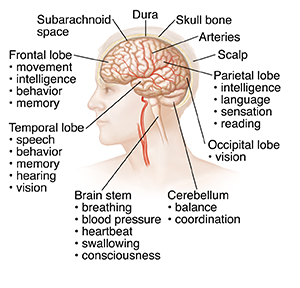Understanding the Brain
The brain controls the entire body. The main areas of the brain include the cerebrum, cerebellum, forebrain, and brain stem. The cerebrum is divided into 2 halves that have 4 parts, called lobes. The 4 lobes are the frontal lobe, temporal lobe, parietal lobe, and occipital lobe. Different areas of the brain have different jobs. Some parts of the brain control basic things like breathing, blood pressure, and heartbeat. Other parts control more complex jobs, such as moving, thinking, speaking, the 5 senses, and memory.

Inside the skull
Under the scalp and the skull, a tough membrane (the dura) surrounds the brain. Beneath the dura, cerebrospinal fluid (CSF) cushions the brain and circulates in the subarachnoid space. Arteries carry oxygen-rich blood and nutrients throughout the brain. Without this blood, brain tissue quickly dies. The brain is made up of about 100 billion cells called neurons. These neurons allow the brain to do its many jobs.
Not pictured here is the forebrain. This part of the brain contains the thalamus, hypothalamus, and pituitary gland. The thalamus sends impulses from the sense organs to the cortex. The hypothalamus controls hunger, thirst, temperature, aggression, and sex drive. It also controls the pituitary gland, which controls the secretion of many hormones.